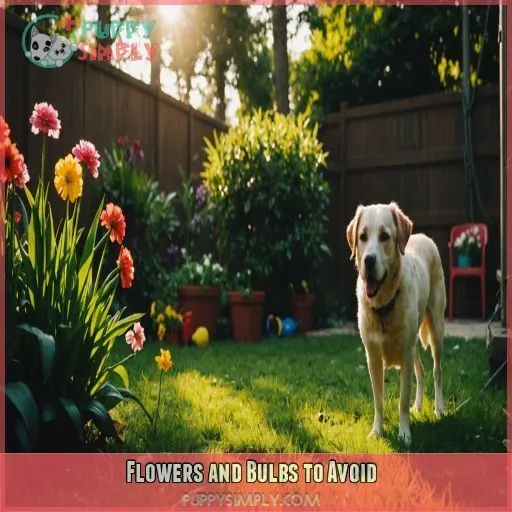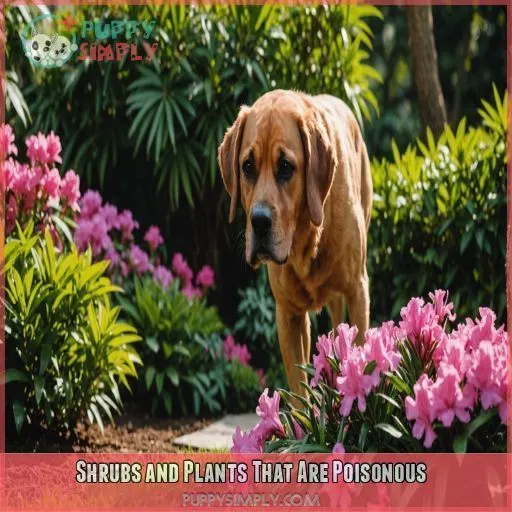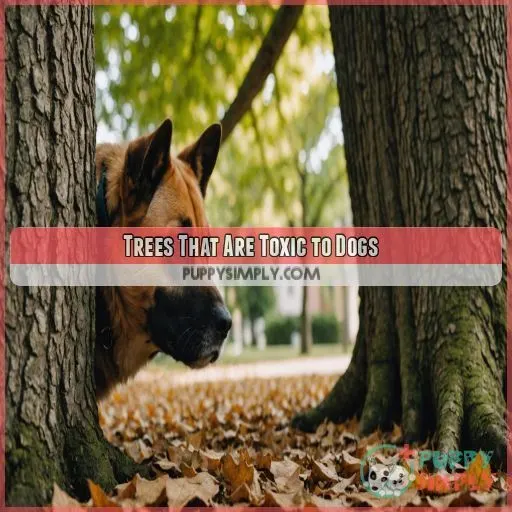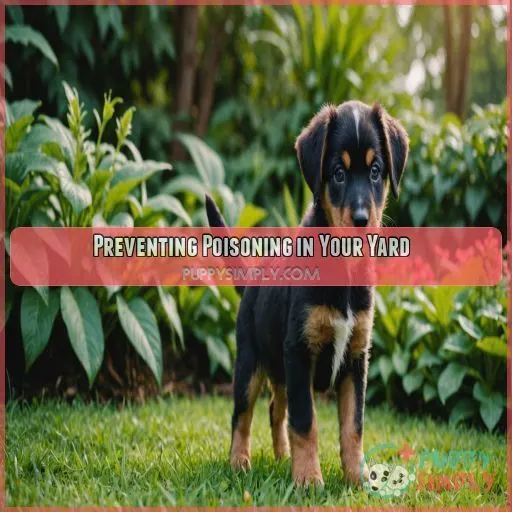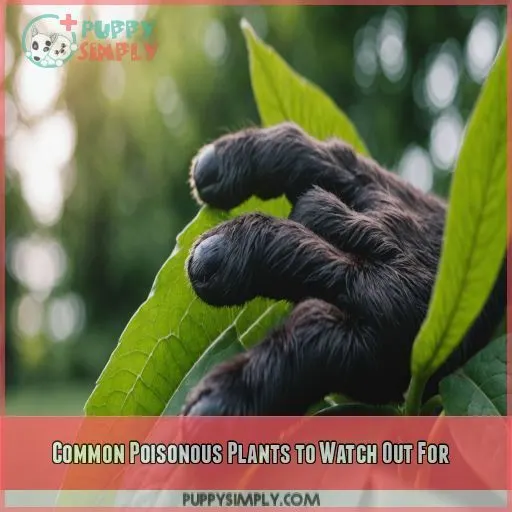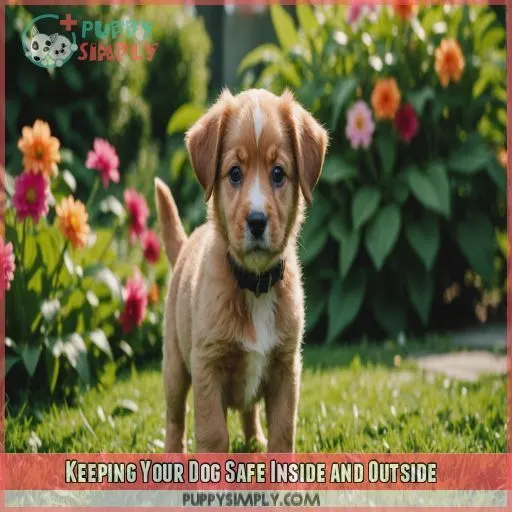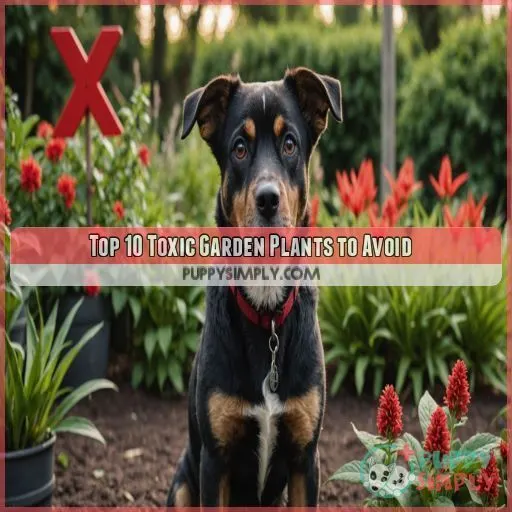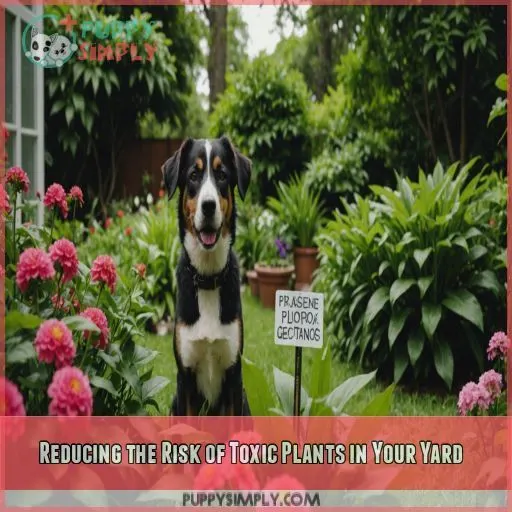This site is supported by our readers. We may earn a commission, at no cost to you, if you purchase through links.
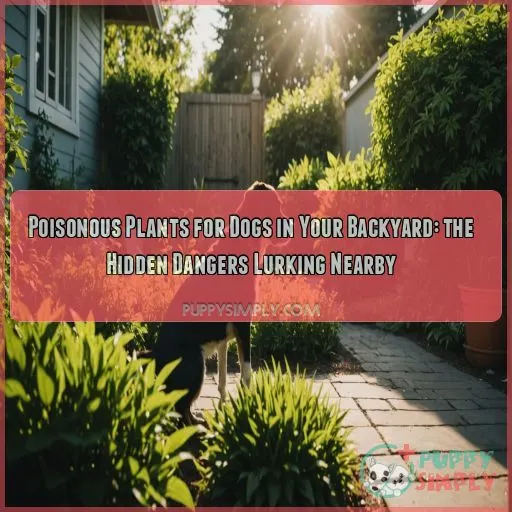 The great outdoors – where your furry friend loves to roam free!
The great outdoors – where your furry friend loves to roam free!
But, beware: your backyard might be harboring some hidden dangers.
Poisonous plants for dogs in the backyard are more common than you think.
From Autumn Crocus and Begonia to Chrysanthemum and Daffodil, these lovely flowers can be toxic to your pup.
Even a small amount can cause vomiting, diarrhea, and liver failure.
Don’t panic!
By knowing what to look out for and taking simple precautions, you can create a safe haven for your dog.
Ready to learn how to spot these sneaky plants and keep your furry friend safe?
Table Of Contents
- Key Takeaways
- Flowers and Bulbs to Avoid
- Shrubs and Plants That Are Poisonous
- Trees That Are Toxic to Dogs
- Preventing Poisoning in Your Yard
- Common Poisonous Plants to Watch Out For
- Keeping Your Dog Safe Inside and Outside
- Top 10 Toxic Garden Plants to Avoid
- Reducing the Risk of Toxic Plants in Your Yard
- Frequently Asked Questions (FAQs)
- What is the most toxic plant to dogs?
- Do dogs know to avoid poisonous plants?
- Is there a grass that is poisonous to dogs?
- What weeds are poisonous to dogs?
- What are common symptoms of plant poisoning in dogs?
- How can I protect my dog from toxic plants outdoors?
- Are there any dog-friendly alternatives to toxic plants?
- Can I use pesticides on toxic plants to kill them?
- What should I do if I suspect plant poisoning in dogs?
- Conclusion
Key Takeaways
- You’re not a botanist, but you’re about to become a pro at spotting those sneaky poisonous plants in your backyard! Knowing what’s lurking in the shadows is key to keeping your furry friend safe, so take some time to survey your yard and identify any toxic plants.
- Don’t assume your dog will instinctively avoid poisonous plants—that’s just a myth! Keep a watchful eye on your pup, especially in areas with toxic plants, and consider dog-proof fencing to restrict access to hazardous areas.
- You don’t have to choose between a beautiful yard and a safe one—there are plenty of Dog-Friendly Plants that are just as gorgeous as their toxic counterparts! Consider swapping out poisonous plants for pet-friendly alternatives like sunflowers, zinnias, and snapdragons.
- If you suspect plant poisoning, don’t panic—but do act fast! Call your vet, the Pet Poison Helpline (855-764-7661), or rush to an emergency vet—every minute counts, and prompt treatment can make all the difference in keeping your furry friend safe and healthy.
Flowers and Bulbs to Avoid
As you’re enjoying the beauty of your backyard, you mightn’t realize that some of those gorgeous flowers and bulbs can be toxic to your furry friend. From Autumn Crocus and Begonia to Chrysanthemum and Daffodil, you need to know which flowers and bulbs to avoid to keep your dog safe and healthy.
Autumn Crocus and Begonia Toxicity
If you’re thinking about plants for your garden, Autumn Crocus and Begonia are two that can be dangerous for pets. Even a tiny bit of Autumn Crocus can cause vomiting, diarrhea, and liver failure. Begonia tubers can irritate your dog’s mouth and make swallowing difficult. If you suspect poisoning, contact the Pet Poison Helpline (855-764-7661) immediately for guidance.
Chrysanthemum and Daffodil Poisoning
Chrysanthemums and daffodils are two more flowers that can be dangerous for dogs.
If your dog ingests these flowers, they might experience vomiting, tremors, and even heart problems.
Keep an eye out for excessive drooling and skin rashes.
Don’t hesitate to call your vet or the Pet Poison Helpline if you suspect poisoning.
Daisies and Their Mild Toxicity
Now that we’ve covered the toxic heavy-hitters like Chrysanthemum and Daffodil, let’s talk about Daisies and their mild toxicity. While they aren’t as poisonous as some other flowers, eating large amounts can still cause tummy troubles in your furry friend. Here are 4 things to keep in mind:
- Mild doesn’t mean safe: Daisy toxicity can still cause vomiting and diarrhea.
- Some Daisies are safer than others: Look into safe species like Gerbera Daisies.
- Keep an eye on your pet’s snacking: If your dog loves to munch on Daisies, consider replacing them with dog-friendly alternatives.
- Better safe than sorry: If you suspect your dog has ingested Daisies, contact the Pet Poison Helpline (855-764-7661) for advice.
Shrubs and Plants That Are Poisonous
As you tend to your garden, you need to be aware of the hidden dangers that could be lurking among the shrubs and plants, threatening your furry friend’s health and well-being.
From aloe vera to azalea, holly to hydrangea, and certain types of ivy, some of the most beautiful and seemingly harmless plants can be toxic to dogs.
These plants can cause everything from mild discomfort to life-threatening conditions.
Aloe Vera and Azalea Toxicity
You love your backyard oasis, but some plants are hidden dangers for your furry friend. Aloe Vera, for instance, is toxic to dogs – the gel may be great for humans, but it can cause vomiting and diarrhea in canines. Azaleas are also a no-go, with even a few leaves potentially leading to vomiting, diarrhea, and even death.
Holly and Hydrangea Poisoning
Be cautious with holly and hydrangea in your yard! While they add festive flair, their toxic leaves and flowers can harm your furry friend. If ingested, symptoms include vomiting, diarrhea, and lethargy. Act fast if you suspect poisoning and contact your vet or the Pet Poison Helpline. Prevention is key: restrict access and choose pet-friendly garden plants instead.
Ivy and Its Toxic Varieties
With ivy, not all varieties are created equal – some can be toxic to your furry friend. Here are a few things to keep in mind:
- Identify the type of ivy in your yard to determine if it’s toxic
- Watch for symptoms like excessive drooling, vomiting, and difficulty breathing
- If you suspect ivy poisoning, contact your vet or the Pet Poison Helpline immediately
- Consider replacing toxic ivy with pet-friendly alternatives like Creeping Jenny or Sweet Woodruff
Trees That Are Toxic to Dogs
As you’re taking care of your furry friend, you’ll want to know which trees in your backyard could be toxic to them.
Some of the culprits might surprise you.
From Black Walnut and Chinaberry to Fruit Trees and Japanese Yew, we’ll explore the trees that are poisonous to dogs and what you can do to keep your pup safe.
Black Walnut and Chinaberry Poisoning
As you survey your yard, don’t overlook those majestic trees – some can be toxic to your furry friend! Black walnut trees, for instance, can cause digestive upset and even seizures in dogs if they ingest decaying nuts. Chinaberry trees are also culprits, with all parts of the tree being toxic, leading to vomiting, diarrhea, and weakness.
Fruit Trees and Their Toxic Pits
You might be surprised to learn that those delicious fruit trees in your backyard can be toxic to your furry friend. The pits of plums, apricots, peaches, cherries, and apples contain amygdalin, a toxin that can cause vomiting, diarrhea, and even respiratory failure. Here are some key things to keep in mind:
- Fruit tree pit dangers: apricot, plum, peach, cherry, and apple pits are all toxic.
- Pit toxicity levels vary, but it’s best to err on the side of caution.
- Safe fruit trees include figs, pears, and persimmons.
- Pit removal tips: dispose of pits safely, and wash your hands afterward.
- Dog-friendly alternatives: consider planting a dog-friendly tree, like a magnolia or a willow.
Horse Chestnut and Japanese Yew Toxicity
If you’re worried about your dog getting into trouble with poisonous trees, horse chestnut and Japanese Yew are two you need to watch out for. If your dog eats horse chestnut, they might throw up, have diarrhea, and even have seizures. Japanese yew is even more dangerous, and eating it can cause deadly heart problems.
| Tree | Symptoms |
|---|---|
| Horse Chestnut | Vomiting, diarrhea, seizures |
| Japanese Yew | Vomiting, diarrhea, fatal heart problems |
Preventing Poisoning in Your Yard
As you let your furry friend roam free in the backyard, you might be unwittingly exposing them to poisonous plants that can cause serious harm. By taking proactive steps to identify and remove these toxic plants, you can create a safe haven for your dog to play and explore without worrying about their well-being .
Knowing Your Yard and Restricting Access
Now that you know which trees to avoid, it’s time to get familiar with your yard. Take a closer look around and identify any potential threats. Create a safe zone for your furry friend by setting up dog-proof fencing and removing any toxic plants. Make sure your outdoor space is pup-friendly and poison-free by doing a yard audit.
Consulting a Landscaper and Being Proactive
Now that you know your yard, it’s time to get proactive! Consult a landscaper who’s familiar with dog-safe plants to help you create a yard that’s both beautiful and safe. Here are 4 steps to take:
- Get a yard audit: Identify all the plants in your yard and flag the toxic ones.
- Remove and replace: Swap out poisonous plants for dog-friendly ones.
- Choose the right grass: Opt for a grass type that’s safe for your furry friend to roll around in.
- Keep an eye out: Regularly inspect your yard for any new plants that might be toxic to your dog.
Creating a Dog-Friendly Yard
You’ve removed the toxic plants, now it’s time to get creative. Think dog-friendly fencing, safe landscaping, and dog-safe plants. Here are some ideas to get you started:
| Dog-Friendly Plants | Safe Landscaping | Yard Maintenance |
|---|---|---|
| Blueberries | Raised beds | Regular pruning |
| Sunflowers | Gravel paths | Natural barriers |
| Lavender | Secure fencing | Yard surveys |
| Grasses | Water features | Plant labeling |
| Roses | Mulch | Soil testing |
Make your yard a haven for your furry friend. With a little planning, you can create a safe and fun space for them to enjoy.
Common Poisonous Plants to Watch Out For
As you’re surveying your yard for potential dangers, you need to know which plants are poisonous to your furry friend. From English ivy and lily of the valley to oleander and sago palm, there are many common plants that can cause harm to your dog, so let’s take a closer look at some of the most toxic ones to watch out for .
English Ivy and Lily of the Valley Toxicity
As you explore your backyard, beware of English Ivy and Lily of the Valley – both toxic to dogs. English Ivy can cause excessive drooling, vomiting, and difficulty breathing, while Lily of the Valley can lead to vomiting, diarrhea, and even heart problems. If you suspect ingestion, contact the Pet Poison Helpline (855-764-7661) immediately for treatment options.
Oleander and Sago Palm Poisoning
As a dog owner, you want to keep your furry friend safe from harm. But did you know that Oleander and Sago Palm can be toxic to dogs? Ingesting these plants can cause vomiting, diarrhea, and even heart problems. Stay vigilant and take steps to prevent poisoning.
- Keep Oleander and Sago Palm out of reach
- Recognize symptoms: vomiting, diarrhea, lethargy
- Contact your vet or Pet Poison Helpline immediately
- Don’t induce vomiting unless advised by a vet
- Regularly survey your yard for toxic plants
Tulip and Hyacinth Toxicity
You’re probably aware that tulips and hyacinths are toxic to dogs, but do you know the symptoms?
If your dog ingests these plants, they may experience:
- Vomiting
- Diarrhea
- Excessive drooling
In severe cases, it can lead to respiratory problems and even heart issues .
Keep these plants out of reach, and if you suspect ingestion, contact your vet or the Pet Poison Helpline immediately .
Keeping Your Dog Safe Inside and Outside
As you take steps to dog-proof your home and yard, you need to know the poisonous plants that can harm your furry friend, both indoors and outdoors. By knowing what to watch out for and taking simple precautions, you can create a safe and happy environment for your dog to thrive in, free from the hidden dangers of toxic plants .
Indoor Plants to Avoid
As you cozy up indoors with your furry friend, beware of sneaky indoor plant dangers! Toxic houseplants like Aloe Vera, Begonia, and English Ivy can wreak havoc on your dog’s health. Swap them for pet-friendly alternatives like Spider Plants or Parlor Palms. Your pup will thank you! Make sure those toxic leaves are out of reach.
Outdoor Plants to Watch Out For
Now that we’ve covered the indoor plants to avoid, let’s head outside! When it comes to outdoor plants, it’s important to be aware of what to watch out for. Here are three common outdoor plants that are toxic to dogs:
- Black Walnut: Its decaying nuts can cause digestive upset and seizures.
- Horse Chestnut: The toxins can cause vomiting, diarrhea, and convulsions.
- Japanese Yew: This tree is extremely toxic, and all parts can be fatal.
Creating a Safe Environment
As a dog owner, you want to create a safe environment for your furry friend.
Start by surveying your yard for toxic plants and removing them.
Consider dog-safe landscaping options.
Fence your yard to prevent escape artists.
Keep an eye out for suspicious plants on walks and educate yourself on toxic plant identification.
Yard safety tips are just a sniff away!
Top 10 Toxic Garden Plants to Avoid
As you create a haven for your furry friend in your backyard, it’s important to know which plants to steer clear of to avoid any harm. Here are the top 10 toxic garden plants to avoid, because you want your dog’s playtime to be filled with fun, not frantic vet visits.
Amaryllis and Autumn Crocus Toxicity
You love decorating with Amaryllis and Autumn Crocus, but beware – their bulbs are toxic to dogs! Amaryllis can cause vomiting, diarrhea, and abdominal pain, while Autumn Crocus symptoms include seizures and liver failure. Prevent pet poisoning by identifying these plants, keeping them out of reach, and opting for dog-friendly alternatives. Your furry friend’s safety is worth it!
Castor Bean and English Ivy Poisoning
As you continue to dog-proof your yard, don’t overlook the Castor Bean and English Ivy. Castor Bean seeds can cause vomiting, diarrhea, and abdominal pain in dogs. English Ivy, while pretty, can lead to excessive drooling, vomiting, and difficulty breathing. Remove these plants to prevent poisoning, and if your dog ingests them, seek vet help immediately.
Hydrangea and Japanese Yews Toxicity
Let’s talk about two toxic plants you don’t want in your yard: Hydrangea and Japanese Yew. Hydrangea flowers and leaves can cause vomiting, diarrhea, and lethargy in dogs. Japanese Yew is even more toxic, with all parts of the plant being potentially fatal. Identify and remove these plants to keep your furry friend safe.
Reducing the Risk of Toxic Plants in Your Yard
When you’re setting up a backyard haven for your furry friend, it’s important to make sure the plants you choose won’t harm them.
After all, your dog’s curiosity and love for sniffing and tasting can sometimes get the best of them.
Removing Toxic Plants and Replacing With Dog-Friendly Ones
Now that you’ve identified the toxic plants in your yard, it’s time for a plant swap! Replace those poisonous plants with dog-friendly options like petunias, sunflowers, or zinnias. This will keep your furry friend safe, and it’ll also give your yard a fresh new look. Think of it as a makeover for a safer, happier yard!
Supervising Your Dog and Being Aware of Their Surroundings
As you let your furry friend explore the great outdoors, keep a watchful eye out!
Supervising your dog and being aware of their surroundings is key to avoiding toxic plant mishaps.
Know your yard’s trouble spots and consider dog-proofing your fence for added safety.
Educating Yourself on Toxic Plants
Now that you’re supervising your dog like a pro, it’s time to get educated on toxic plants. Familiarize yourself with plant identification, common symptoms, and resources for help. Create a plant safety checklist to make sure your yard is dog-friendly. By knowing what to look out for, you’ll be better equipped to prevent accidents and keep your furry friend safe.
Choosing Dog-Friendly Grass and Plants
Now that you’re educated on toxic plants, it’s time to choose dog-friendly grass and plants for your lawn. You want a safe and happy haven for your furry friend to frolic in. Here are three options to get you started:
- Dog-friendly grass seed options: Look for varieties like Buffalo Grass, Blue Grama Grass, or Bermuda Grass.
- Pet-friendly plants: Try groundcovers like Creeping Thyme, Sedum, or Vinca minor.
- Groundcover alternatives: Consider Mulch, Pine Straw, or Cedar Chips instead of toxic plants.
Fencing Your Yard and Creating a Designated Dog Zone
Now that you’ve chosen dog-friendly grass and plants, it’s time to think about fencing your yard and creating a designated dog zone. Invest in dog-proof fencing to keep your furry friend safe from toxic plants and other hazards. Consider a DIY fencing project or consult with a professional to design a safe and fun zone for your dog to enjoy.
Regularly Surveying Your Yard for Toxic Plants
Regularly checking your yard for toxic plants is really important to keep your furry friend safe. Don’t assume you know what’s lurking in the shadows – take a closer look. As the seasons change, new culprits can emerge.
- Take a snapshot of your yard in different seasons to track changes
- Research plants you’re unsure about
- Keep an eye out for new growth or unexpected sprouts
- Involve your family in the process to spread awareness
- Create a "plant patrol" routine to stay on top of it
Frequently Asked Questions (FAQs)
What is the most toxic plant to dogs?
Beware, the ultimate supervillain of plants is lurking! The Japanese Yew is a toxic titan, with even a tiny nibble capable of being fatal to your furry friend – so keep it far, far away!
Do dogs know to avoid poisonous plants?
Don’t count on your furry friend to steer clear of poisonous plants – the myth that dogs instinctively avoid toxic plants is just that, a myth! Keep a watchful eye and take steps to protect them.
Is there a grass that is poisonous to dogs?
Watch out for Pampas Grass and Grass Palm – they’re toxic to dogs! Pampas Grass seed heads can cause severe irritation, while Grass Palm’s saponins can lead to vomiting, diarrhea, and liver damage .
What weeds are poisonous to dogs?
When it rains, it pours" – and toxic weeds can be a real downpour for your furry friend! Watch out for pesky plants like Autumn Crocus, Begonia, and Chrysanthemum, which can cause vomiting, seizures, and skin rashes in dogs.
What are common symptoms of plant poisoning in dogs?
If your furry friend has ingested a toxic plant, watch out for common symptoms like vomiting, diarrhea, excessive drooling, lethargy, seizures, and difficulty breathing – and act fast by contacting your vet or the Pet Poison Helpline!
How can I protect my dog from toxic plants outdoors?
Imagine over 700 plants are toxic to your furry friend! To protect your dog outdoors, survey your yard regularly, restrict access to hazardous plants, and consider consulting a landscaper to create a dog-friendly zone.
Are there any dog-friendly alternatives to toxic plants?
You can swap toxic plants for dog-friendly alternatives like sunflowers, zinnias, and snapdragons. These colorful blooms are non-toxic and add a pop of color to your yard, keeping your furry friend safe and happy!
Can I use pesticides on toxic plants to kill them?
Don’t even think about using pesticides to kill toxic plants – you’ll just trade one danger for another. Instead, consider consulting a landscaper or gardening expert to safely remove the plants and recommend dog-friendly alternatives.
What should I do if I suspect plant poisoning in dogs?
Your dog’s life is literally hanging by a thread! If you suspect plant poisoning, act fast: call your vet, the Pet Poison Helpline (855-764-7661), or rush to an emergency vet – every minute counts!
Conclusion
Congratulations, you’re now a master of spotting those sneaky poisonous plants for dogs in your backyard!
Who knew being a responsible pet parent involved being a part-time botanist? But seriously, it’s vital to know what’s lurking in your yard.
By being proactive and aware of poisonous plants for dogs in your backyard, you can create a safe haven for your furry friend to frolic and play.
Happy planting – and pup-parenting!

